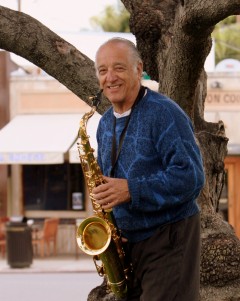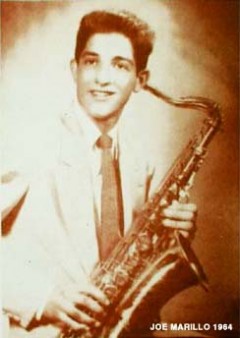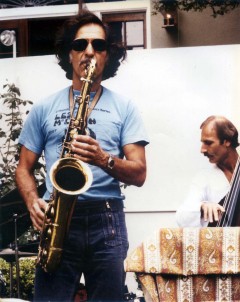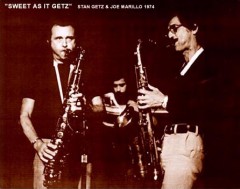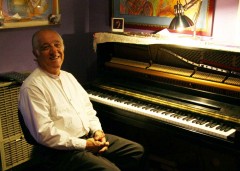Featured Stories
Joe Marillo: An Inspiration to Us All
At La Jolla’s old Chuck’s Steak House, in a cramped jazz lounge off to the side of the main dining room that seemed no bigger than a studio apartment, saxophonist Joe Marillo held forth on a miniscule stage, lifting his instrument above his chest, his back arched, letting fly with a rapid succession of notes that danced atop the pulse of a racing walking bass and the cymbal riding sweep of an earnest drummer. Wild as this might sound, the proverbial box of pots and pans dropped a flight of stairs yet Marillo and group were in the moment, the essence of jazz greatness, the duality of tossing caution aside, of forgetting formal training and the rules of engaging a song, and still finding extemporaneous musical beauty.
The hours of wood shedding; practice; and learning from flubs, goofs, and gaffes that were refined until licks and phrases became syntax for a tongue bypassing the logic of words, every slight, insult, belly laugh, fist fight, and love affair insinuating itself in each quarter note pause, each accelerated race of scales, each bluesy bend and gracious strut, turning the mere technique into a very real voice, tempered by experience. Technique is merely a matter of mechanics, skills an aptitude you demonstrate when you’re working for a grade. Talent, though, is what you learn, when theory meets practice. Practice meant playing with out the safety net as you showed the world what it was you’ve learned and the depth of personality you bring to the technique. Joe’s personality was deep, varied, sprite and somber, lyric and abrasive, emerging fully, masterfully from his instrument, the embodiment of a quote attributed to Charlie Parker:
Music is your own experience, your own thoughts, your wisdom.
If you don’t live it, it won’t come out of your horn.
They teach you there’s a boundary line to music.
But, man, there’s no boundary line to art….
This was in the seventies, between 1973 through 1975. I can’t locate the exact date in my mind, but it’s a vivid memory all the same. I was working in a string of quizzical jobs–a poet and an occasional rock critic becoming rapidly bored by the calcified likes of rock ‘n’ roll and cautiously investigating jazz, the music of snobs, old people, and tonal chaos. I was watching Joe Marillo, who seemed to transport himself into dimensions without names as he blew and let his fingers fly over the saxophone keys, and then I understood that I didn’t need to understand what he was doing. All there was to do was listen as the allusive complexity of the improvisations cohered and provided the continuous sounds of revelation. I began to grasp the concept I could not grasp previously.
However much Joe seemed to be in a state of transcendence while he was in the throes of improvisational excursion when the music wound down–muted cymbal hisses and piano, bass and guitar fills diminishing in volume and speed as the leader offered one last, rich cadenza that concluded his sortie on a low, richly sustained major note–he stood up, opened his eyes, and looked about the lounge, an overcrowded room of San Diegans fortunate enough to experience Marillo’s bifurcated grooves. He looked squarely in the direction I was sitting. “We’re going to take a short break, have a drink, and let’s keep this scene going, eh?”
I sat with two of Joe’s friends, Robert and Jeri, and we were lucky enough to, among the comparative few, have a table inside the circumscribed lounge. They were pals I had since my early days as a UCSD undergraduate literature student and poet in the making. Robert, someone with a detailed knowledge and deep affection for music that was improvised, experimental, full of odd elements and outside the four-chord strictures of pop music, suggested we see Marillo and his band that night at Chuck’s. Robert suggested that Joe might be amenable to letting me sit in with my harmonica for a blues tune. Joe positioned his saxophone on a stand, grabbed his drink, and walked over our table. Fast and animated, Joe brought Robert and Jeri up to speed about what he was planning to do: start up his own jazz series at the Catamaran in Pacific Beach. Robert and Jeri did much the same, the conversation a blur, with rushed words and hasty summations of what had been going on over the weeks since they last saw each other, but altogether amiable, the kind of quick camaraderie among friends who understand the moods of their friends quickly when time was pressing. Joe looked at the “C” blues harmonica I had placed on the table, a cheesy habit I developed: put the instrument in conspicuous view and hope a professional musician would take the bait and ask me to play with him. It worked sometimes; other times the harmonica was ignored. Joe asked one question, pointing to the harmonica.
“What key is that thing in?” I told him that it was in the key of C.
“Tell you what,” he said, his voice a friendly, honking rasp, “you’re going to play a blues with us on the next song, when we start the next set.”
Play we did, a slow blues in G, myself trying to follow the augmented I-IV-V progression, Joe’s saxophone seasoning the groove with short fills, blurts, aching squeals, the drummer giving accenting key points of tension, and the pianist tinkling the keys with manic trills and quicksilver runs. Joe leaned over as I held the harmonica to the mic and the mic up to my mouth, likely looking to the crowd like someone who hadn’t eaten in a week who finally got his hands on a Big Mac and a side of fries. He offered these fateful words: “Go ahead, man, it’s all yours.” Play I did, and not all that well, my ideal sound being Paul Butterfield crossed with copious amounts of Sonny Terry, but the crowd provided a visible approval, heads nodding, bobbing, men with their eyes closed as though they were playing the mournful tones, women swaying in their seats, long hair fanning the table tops and overpriced drinks. My first note was a low moan, a bend on the two-draw note, next up to three draw, a construction of textures based on the progression. And so it went for two choruses, me intoning the riffs of the masters, the sounds coming out the house PA system and muffled by the collective sound of the band hammering hard on the grit that made Mississippi great. Joe was yelling “Yeah” at one point, near the last bit of my solo, giving me a start. I missed the groove
The crowd applauded and cheered, though. Joe patted me on the back and gently pushed me from the stage, friendly but firm. The band increased in volume and Joe took possession of the spot again. Center stage was a place where Joe Marillo belonged, gathered with musicians dedicated to making a living playing what is arguably America’s greatest music. In the 40 plus yeas that I listened to him, there seemed to be no style he couldn’t perform masterfully with his horn. There was the Coltrane factor where the register was jumping with steeple-chase changes of “Giant Steps,” which were negotiated with ease and panache by Joe. There was the large, blasting harmonics of Gato Barbieri when the groove went Latin-jazz and the notes assumed extra urgency; there was the delicate, ribbon-lyricism of a Paul Desmond when he did a ballad, his tone subdued, softer, investigating the emotions contained between a composer’s scripted subtle melodic configurations.
It needs to be said here, I think, that above all else, Joe Marillo was a master of his instrument, in my estimation, as well as a the pioneering musician whose legwork convinced a good number of restaurants, clubs, hotels, and cafes to regularly program jazz. Not long after seeing him for the first time at Chuck’s Steak House, Joe created the Society for the Preservation of Jazz, a group that was dedicated to exposing jazz to San Diegans who, at the time, had precious few spots to hear the music performed. He opened his series at the Catamaran and booked jazz legends Sarah Vaughn and Art Pepper among a wonderful string of artists. He had been named “the Godfather of San Diego Jazz,” and it was a nickname he earned. He played all over the county–from East County, Downtown, and the beach area to the North County, spreading his kind of full-throttle jazz to anyone who cared to show up and listen. Something took, I think, all these years later since Joe first campaigned for the music. What we have in our variety of jazz and jazz-friendly venues is due in large part by Joe.
The short and long of it is that Joe Marillo improved the cultural life of San Diego in ways difficult to calculate, which is a more qualified way of saying that he improved life on his planet, period. Had it not been for Joe putting jazz where it had not been before in this sun-glutted burg, my tastes in music would have been impoverished beyond tolerance. Marillo was part of this young man’s education in what makes being alive worth the trudging and setbacks. I thank Joe Marillo for the lessons taught.
Dizzy’s is hosting a tribute to Joe on Tuesday, May 24, 7pm, featuring musicians who worked with him, plus a photo exhibit.






